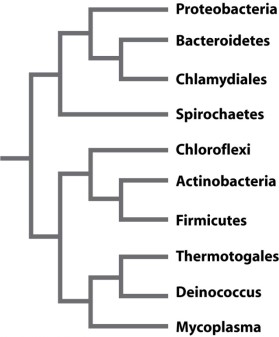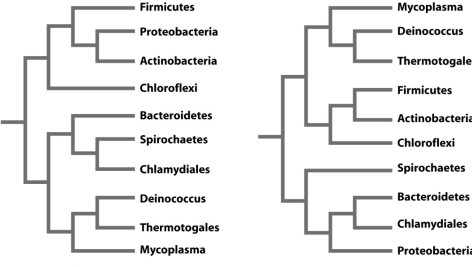Multiple Choice
Scientists generate phylogenetic trees for a group of organisms using molecular data such as gene sequences. The 16S rRNA gene is used for this type of analysis because the gene phylogeny accurately reproduces the evolutionary history of the organisms from which the sequences were derived. Assume that the phylogeny below, which was produced based on analysis of the 16S rRNA gene, represents the evolutionary history of bacteria.  You are interested in determining other genes that may be used to recover the same phylogeny. For each microbe in the tree, you sequence two other genes. The first is rpoB, which encodes one of the subunits in RNA polymerase holoenzyme and is located on the bacterial chromosome. The second is cat, a gene that confers resistance to the antibiotic chloramphenicol (a drug that targets the ribosome) and is located on a plasmid. Examine the two trees below. On the left is the phylogeny recovered using cat sequences and on the right is the phylogeny recovered using rpoB sequences.
You are interested in determining other genes that may be used to recover the same phylogeny. For each microbe in the tree, you sequence two other genes. The first is rpoB, which encodes one of the subunits in RNA polymerase holoenzyme and is located on the bacterial chromosome. The second is cat, a gene that confers resistance to the antibiotic chloramphenicol (a drug that targets the ribosome) and is located on a plasmid. Examine the two trees below. On the left is the phylogeny recovered using cat sequences and on the right is the phylogeny recovered using rpoB sequences.  One of the two trees supports the hypothesis presented in the 16S rRNA gene phylogeny for this group of bacteria. Which of the following helps to explain why only one of the two trees matches the 16S rRNA gene phylogeny?
One of the two trees supports the hypothesis presented in the 16S rRNA gene phylogeny for this group of bacteria. Which of the following helps to explain why only one of the two trees matches the 16S rRNA gene phylogeny?
A) One of the genes was transferred horizontally between groups of bacteria.
B) Both genes encode proteins responsible for essential functions in all cells.
C) One of the genes is inherited from a common ancestor, passed from parent to offspring.
D) One of the genes gives this group of bacteria a beneficial growth advantage when grown in the presence of antibiotics.
E) One of the genes produces a phylogeny that is the same as the phylogeny produced using the 16S RNA gene.
Correct Answer:

Verified
Correct Answer:
Verified
Q91: It has been suggested that cyanobacteria are
Q92: Which of these trees reflects the hypothesis
Q93: Based on the energy and carbon sources
Q94: Photoheterotrophs rely on sunlight and organic molecules
Q95: A researcher is comparing the sequences of
Q97: Organisms belonging to the Bacteria branch of
Q98: Even without the nitrogen cycle, life on
Q99: Stromatolites are of particular interest to researchers
Q100: An organism classified as a eukaryote could
Q101: Eukaryotes, archaeons, and bacteria can all successfully